Packing for the Overland Track can be a little bit confusing. I did lots of gear research before I walked the Overland Track. I managed to put together a backpack full of gear that wasn’t too heavy or bulky, but still kept me warm and dry in Tasmania’s fickle (and chilly) weather.
Here’s my complete Overland Track packing list. It includes everything you should bring, plus my specific recommendations for gear.
I walked the Overland Track without a guide. So this Overland Track packing list is set up for self-guided hikers who will carry all their own gear and sleep in a tent or the public huts.
For more info on the different ways you can do the Overland Track (including fully guided) check out my Ultimate Guide to the Overland Track.
Hey there: Some of the links in this post are affiliate links, which means I earn a small commission at no cost to you. Thanks for your support. -Taryn
Overland Track Essentials
Trail Permit
When you check in at the visitor centre to start the walk, the ranger will give you a small waterproof, paper permit. Keep it attached to your pack while walking and tied to your tent at campsites.
For more information on how to make Overland Track bookings, get permits and how much they cost, see my Ultimate Guide to the Overland Track.
Guidebook and Map (optional)
If you want, you could definitely do the entire walk without a map or guidebook. There are big info boards inside each of the huts that have a map and trail info for the next section of the walk.
However, I found it helpful to have a map and was also glad I read through a couple of guide books before my trip. To get an idea of what the hike is like, read my section-by-section overview of the Overland Track.
I recommend: Overland Track by John Chapman and Monica Chapman. It’s the most detailed guide to the trail anywhere and includes lots of helpful maps.
I also got the official guidebook, The Overland Track: One Walk Many Journeys from the Tasmania Parks & Wildlife Service. You can buy it when you make your track booking or at the Cradle Mountain Visitor Centre.
If you get the official TASMAP Cradle Mountain and Lake St. Clair map, you won’t need to bring anything else on your walk. It has a big map of the trail on one side. The other side has printed descriptions for each section of trail, an elevation profile (so helpful!), and info on side trips and safety.
You can buy it at shops in Tasmania, at the national park, or online when you make your Overland Track reservations.
Compass and/or GPS (optional)
I use a GPS on all my hikes since I like to be able to see how much further I have to go. We didn’t need the GPS for navigation at all on the Overland Track since it was so well marked.
I recommend: I love the Gaia GPS app for my phone. It has lots of helpful map layers and lets me calculate the distance to the next landmark.
Backpacks and Bags for the Overland Track
Backpack
When looking for a backpack, choose something between 50 and 75L. Do a test pack at home to make sure all your gear fits. Make sure you pick a backpack that fits you well and is comfortable to carry when fully loaded.
I recommend: I took my older Boreas Lost Coast 60 backpack on the trail but sadly it’s discontinued. My husband really likes his Gregory Stout 65. It comes in a women’s version called the Gregory Amber 60.
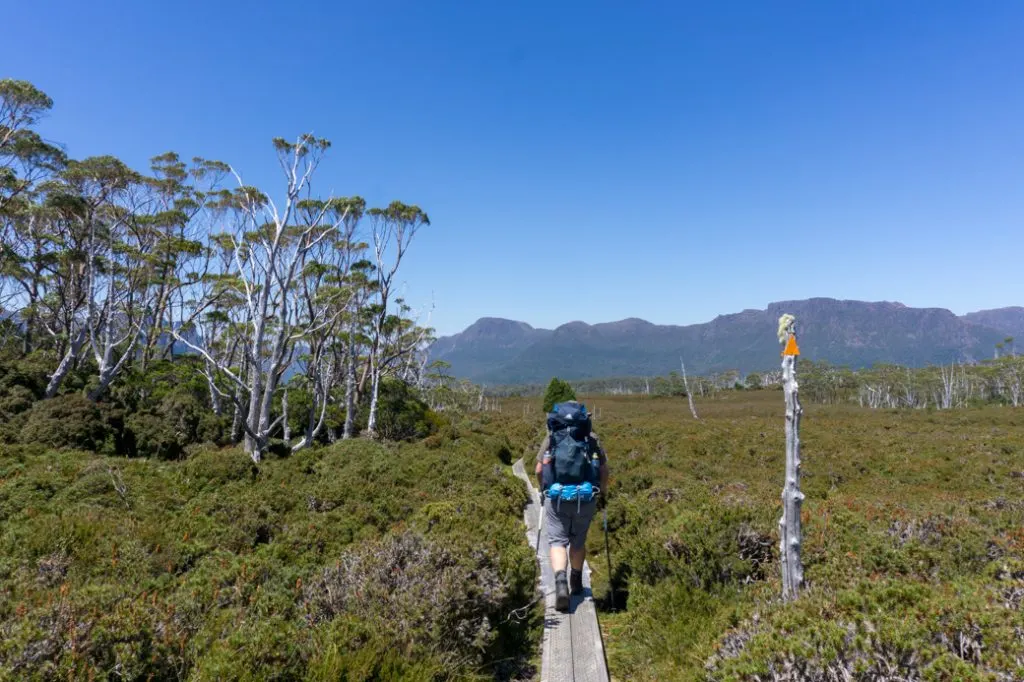
Day Pack
If you plan to do any of the side trips from the Overland Track, you should bring a small packable day pack. That way you don’t have to carry your heavy pack the whole way. Choose one that’s about 20L in size.
I recommend: My husband and I shared the Outdoor Research Dry Summit Pack. It has a roll-top so it’s totally waterproof.
Stuff Sacks and Organizers
To stay organized I like to pack my gear in a combination of different sized stuff sacks. Mostly I use light weight dry bags. It can rain a LOT on the Overland Track so keeping your gear dry is really important.
I recommend: I like the Sea to Summit Ultra-Sil window dry bags. They’re waterproof but still incredibly lightweight. Plus they have a clear panel so you can see what’s inside.
Rain Protection
If your gear gets wet, it can really ruin your trip. We did the Overland Track in the middle of summer. Despite this, we had pouring rain, hail, and snow on January 31st, and a few sprinkles of rain on other days.
I brought a rain cover for my backpack and also brought a couple big bin liners (garbage bags) to wrap up gear inside my pack.
I recommend: Some packs come with a custom sized rain cover. If yours didn’t, buy a lightweight silnylon one that fits your pack well.
Pro tip: If you tend to overstuff your pack or attach things to the outside, buy a slightly larger sized rain cover.

Tent and Sleeping Gear
Tent
The Overland Track is a serious mountain trek. You need a proper hiking tent. Even if you plan to sleep in the huts, you need to bring a tent in case the huts are full or you have an emergency.
Bring a hiking tent that is lightweight, compact and has a full length waterproof rain fly. You can get bad weather at any time up there, so this isn’t the place for a cheap, big-box store tent that will leak.
Since almost all of the campsites on the Overland Track are on wooden platforms, you may want to bring a freestanding tent. It’s challenging, but definitely not impossible to set up a non-free-standing tent on the platforms.
I recommend:
We actually brought a non-free-standing tent, the Zpacks Triplex, on the Overland Track. It took a bit longer to set up on the platforms, but overall it was fine.
We used a few screw-in cuphooks from the hardware store to make sure we could use it on the platforms. (Read my guide to the campgrounds on the Overland Track for more tips.)
The Triplex is a niche, ultralight tent, so if you’re looking for something more mainstream, I recommend the MSR Hubba Hubba. I’ve been using them for over a decade and I can’t say enough good things about them. (Well except that they aren’t cheap!)
If the Hubba Hubba isn’t in your budget, check out the MSR Elixir.
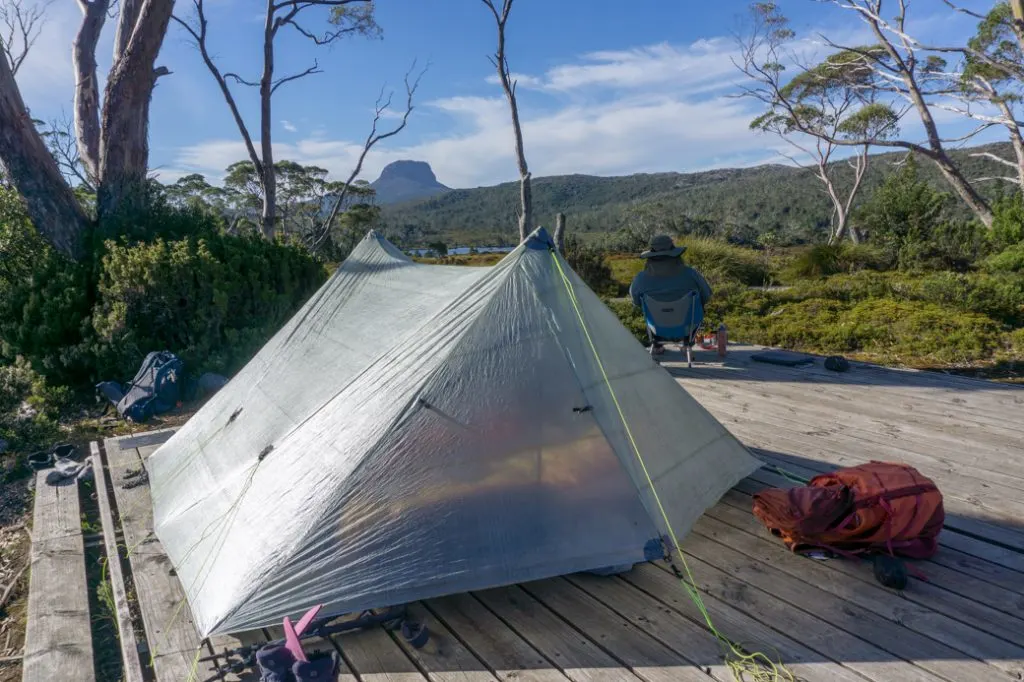
Sleeping Bag and Compression Sack
The campsites on the Overland Track are at or near 1000m elevation and it can be cold up there all year. Pack a lightweight and compressible sleeping bag rated at least 5C but preferably more like -10C. Choose one with a hood for extra warmth.
Make sure you pack your sleeping bag inside a compression sack so it takes up less space in your pack.
I recommend: I sleep cold so on the Overland Track I chose to bring my winter sleeping bag, the Therm-a-Rest Oberon. It was overkill, but I was definitely warm! I like the Outdoor Research Ultralight Compression sacks and they come in lots of sizes.
Sleeping Pad
Even the warmest sleeping bag can’t protect you from the cold ground, a draft underneath the tent platform or a hard hut bunk. You’ll need a sleeping pad for that. Choose one that is compact, lightweight and has an R value of at least 2.5. (R value measures insulation and warmth).
If you expect cold weather or know you feel the cold at night, pick a pad with an even higher R value.
I recommend: I use a Therm-a-rest NeoAir Xtherm since I sleep really cold. My husband likes his NeoAir XLite which weighs less but isn’t quite as warm.
Pillow (Optional)
You can use a bunched up jacket as a pillow, but I recommend adding a compact camping pillow to your Overland Track packing list. Your neck will thank you.
I recommend: I use a simple MEC inflatable pillow. For a slightly more deluxe experience check out the Sea to Summit Aeros Pillow Premium.
Ear Plugs
Ear plugs are a must if you plan to sleep in the huts. You’ll be sleeping centimetres from a snoring stranger and you need to be able to get a good night’s sleep.
As well, some of the tent pads are very close to each other or to the trail.
For more info on sleeping arrangements inside the huts, read my guide to Overland Track huts and campgrounds.
I recommend: Bring a few pairs of cheap foam earplugs. You’re bound to lose some so it’s good to have extras. I like the contoured ones since I find they fit in my ears better.
Clothing
Hiking pants or tights (1 pair)
Choose quick-drying hiking pants made of nylon or polyester (and maybe with a bit of spandex for stretch). Even if it’s warm down at sea level, you’ll definitely want pants up in the chilly mountains of the Overland Track.
I recommend: I love my MEC Terrena Stretch pants. I also like the Prana Halle Pants. If you like convertible pants, the Prana Stretch Zions are a great option.
READ NEXT: 12 Best Women’s Hiking Pants (Picks for Every Body Type)
Shorts (1 pair)
Depending on when you hike the trail, the weather may be warm enough for shorts. I hiked the Overland Track in the middle of summer (started Jan 31) and I wore shorts for about half of the days.
I recommend: The Black Diamond Valley Shorts are my favourite hiking shorts, but sadly they are discontinued.
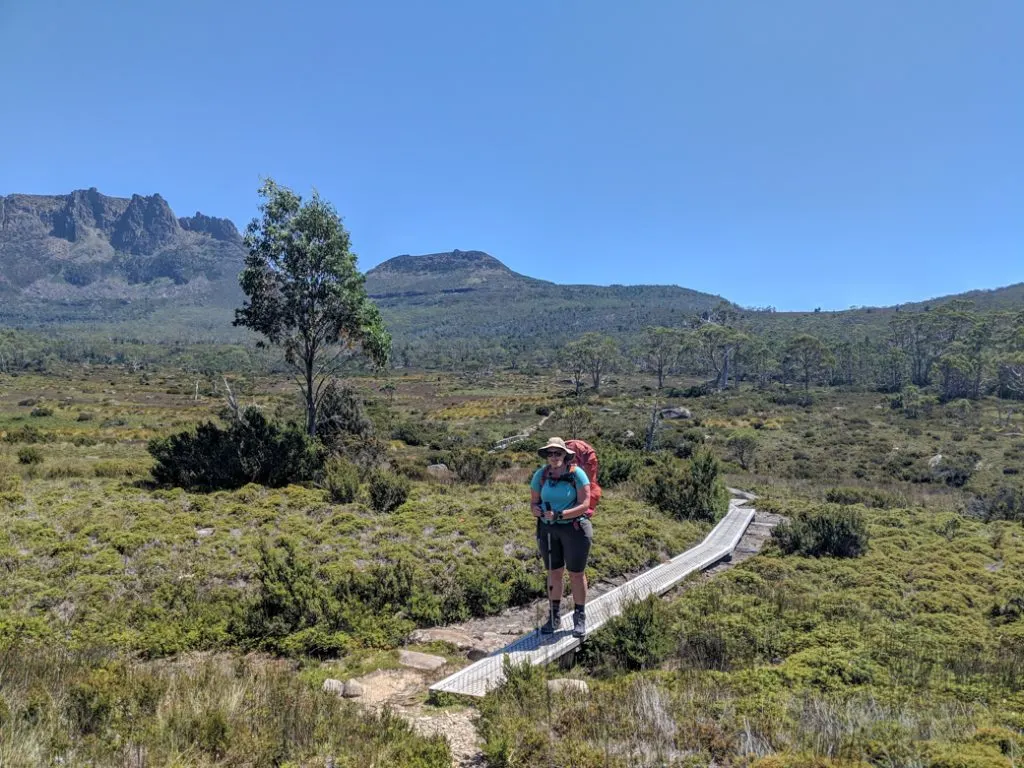
T-shirts (1 or 2)
I usually hike in quick-drying workout t-shirts or singlets. You could also bring a button up trekking shirt.
I recommend: I love the Patagaonia Capilene Cool Trail shirt since it looks like a regular t-shirt but wicks sweat and resists odours. But any old quick-dry polyester workout t-shirt will do. You can pick them up for cheap at big-box or mall stores.
Long sleeved shirt (1)
A long sleeved shirt is a good layer for sun protection or for a bit more warmth on cold mornings. I prefer to wear a long sleeved shirt with buttons or a zip neck so that I have venting options.
I recommend: Look for a long sleeved zip-neck or button up with UPF sun protection. In warmer weather I like a button up trekking shirt.
Fleece Jacket or Light Weight Puffy Jacket
Once the sun goes down, it can be really cold on the Overland Track. Some days its also cold enough during the day that you’ll want a warm layer you can hike in.
Pack a fleece jacket or a lightweight puffy jacket that you can layer on over a t-shirt and under your rain jacket. If you hike the Overland Track in spring or fall, opt for a warmer puffy to wear at camp in addition to a fleece.
I recommend: My husband loves his Patagonia Nano Puff Jacket. For a synthetic puffy it’s really light and warm. It comes in a women’s version too.
Rain jacket
You definitely should pack a rain jacket for the Overland Track since it can rain or snow at any time. And even if it doesn’t rain, it will block the wind. Add a waterproof breathable rain jacket designed for hiking to your Overland Track packing list – preferably one with pit zips for venting.
I recommend: My husband and I both really love our 3 layer Gore Tex MEC Synergy Jackets. If you want something lighter and more compact, the Outdoor Research Helium II is a great option.
Rain Pants
Pack a pair of waterproof breathable rain pants that you can easily layer over top of your hiking pants. I was so glad I had mine on the Overland Track as we had one day of truly terrible weather with rain, snow, hail and high winds.
Ones with side zippers for venting are easy to put on and take off without removing your shoes.
I recommend: I have the MEC Hydrofoil Rain Pants. They have full length side zips so they aren’t as light as the popular Outdoor Research Helium Pants.

Thermal Base Layers
It gets cold up high in the mountains, especially at night so make sure you pack some thermal base layers. Choose mid-weight thermals made of polyester or merino wool and be sure to pack both bottoms and a long sleeved top.
I recommend: I sleep cold so I wear a MEC T3 base layer top with a hood and Smartwool bottoms. My husband likes Patagonia’s Capilene Midweight long underwear.
Psst! Curious if Merino wool is worth it? Read my Merino wool explainer and decide for yourself.
Sports bra
You don’t need a ton of support for trekking, so try to choose a bra without a lot of fabric layers that will take a long time to dry.
I recommend: I really like the Knixwear bras for trekking since they are super lightweight, don’t absorb too much moisture and are seamless so they don’t chafe.
Underwear (2 or 3 pairs)
I like to bring two kinds of underwear on long trips: two or three pairs of quick drying synthetic underwear for trekking and one pair of comfortable cotton underwear for wearing at night.
Seamless underwear will be way more comfortable for hiking in, since they prevent chafing. Many of the guys I hike with swear by boxer briefs with a built in pouch to prevent their package from rubbing the inner thighs.
I recommend: I wear Patagonia’s Active underwear because they’re seamless. The guys I hike with can’t stop talking about how much they love Saxx boxer briefs.
READ NEXT: Best Hiking Underwear For Women and Men
Warm Hat
Bring a fleece or wool hat that covers your ears. It can get really chilly on the Overland Track.
Sun Hat and Sunglasses
The sun can be harsh in Tasmania, especially above the tree line. Bring a wide brimmed hat or baseball cap and a pair of sunglasses for protection.
I recommend: My go to baseball cap is the Sunday Afternoons Trucker.
I also brought the Outdoor Research Oasis Sun Sombrero wide on the Overland Track since it has a wide brim.
I like to wear polarized sunglasses as they cut let you see colours that are truer to reality than what you get with regular sunglasses. I like Sunskis since they have fun frame options and they aren’t too expensive for polarized glasses.
Gloves
Simple fleece or wool gloves will be enough to keep your hands warm at high elevations or on cold mornings. But if you are trekking in spring or fall, or feel the cold easily, insulated ski gloves are a better bet.
I recommend: I like wind resistant fleece gloves since they’re a bit warmer when wet.
Neck Gaiter or Buff (Optional)
When I was trekking in Nepal, my guide Chandra swore that you stayed warmer if you kept your ears covered. He often used a buff as a headband to warm his ears. It turns out that advice works well in the Tasmanian mountains too! You can also wear a buff around your neck or even as a hat.
I recommend: I bring a merino wool buff on all my hikes and was happy I packed it for the Overland Track, especially on chilly days.
Footwear
Hiking Boots
The Overland Track is muddy and rocky. Wear supportive hiking boots and make sure they are waterproof. The most important thing is to bring boots that you’ve already worn already and that are comfortable. You really want to take care of your feet.
I recommend: I love my Salmon X Ultra Mid GTX Boots.
READ NEXT: How to Prevent Blisters When Hiking
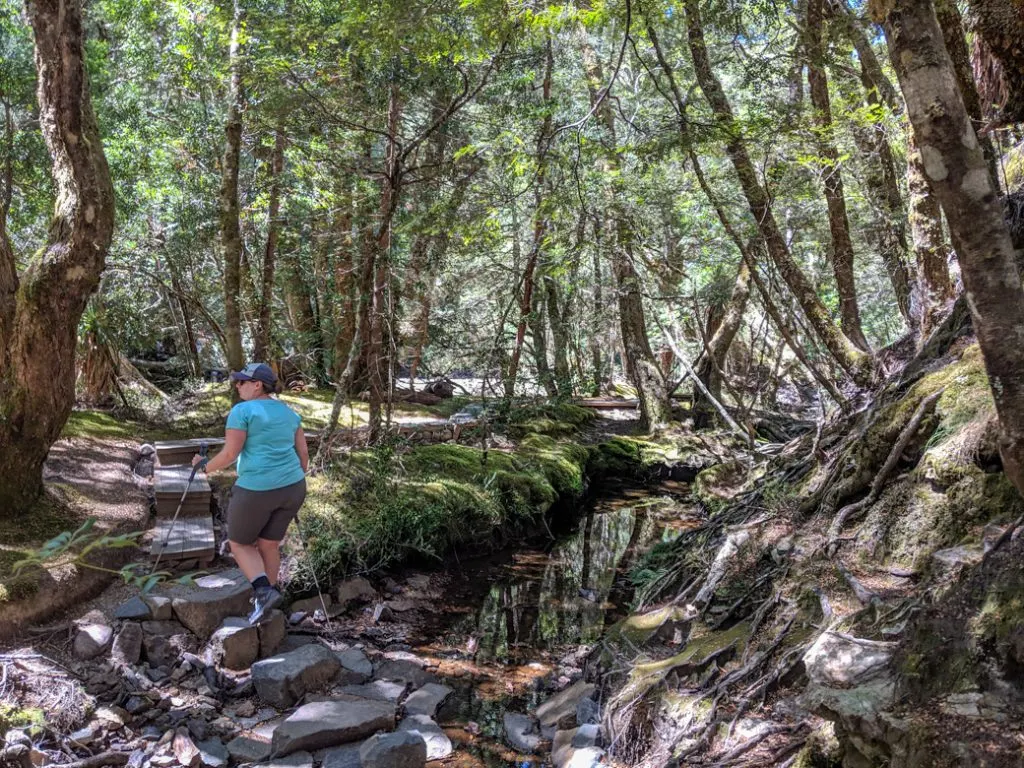
Camp Shoes (Optional)
Pack a lightweight pair of slip on sandals, thongs, or Crocs for around camp. Pick ones that are light and don’t take up too much room in your pack.
I recommend: I brought lightweight flip flops (thongs) on the Overland Track. I wear them with Injinji toe socks for extra warmth!
Socks (2 or 3 pairs)
Keeping your feet happy on a hike is super important. Pack 2 or 3 pairs of wool and synthetic blend socks that fit well.
I also wear liner socks since they can help reduce the rubbing that can cause blisters.
Try your socks and boots at home before your trek to make sure they don’t cause any problems.
I recommend: I’m a recent convert to wearing Darn Tough socks. They’re comfortable and seem to last forever. I wear the Light Hiker Micro Crew.
For liners I love Injinji toe socks since they help prevent blisters between your toes.
Gaiters (Optional)
Most people I saw on the Overland Track wore gaiters. They are helpful to keep mud and water out of your boots in wet weather. They also offer some protection from snake bite.
I hiked the Overland Track in the middle of summer when the track was really dry. I carried a pair of short gaiters, but never wore them. If you hike in spring or fall, I’ve heard the track can get really muddy so gaiters are a must.
I recommend: I have basic Gore Tex gaiters from MEC. REI also makes good entry level waterproof breathable gaiters.
Toiletries, First Aid and Safety
Toothpaste and Toothbrush
I get travel sized tubes of toothpaste from the dentist to take on hiking trips.
Deodorant and Wet Wipes
You’ll be getting sweaty every day. Bring a small travel sized deodorant and some baby wipes for having a quick sponge bath at the end of the day.
Sunscreen and Lip Balm
The harsh Tasmanian sun can give you a sunburn in just a few minutes. Pack sunscreen and SPF lip balm to protect yourself.
Insect Repellent and/or Head Net
In some places the march flies can be terrible. Bring insect repellent.
I like to wear a head net since I don’t like putting chemicals on my face. Be sure to pack a baseball cap or wide brimmed hat to wear underneath – it keeps the netting off your face.
Hair Brush and Hair Ties
If you’ve got long hair, you know why you need these.
Contact Solution and Spare Lenses
If you wear contacts, be sure to pack contact solution and extra lenses. On cold nights, sleep with your contact case inside your sleeping bag to keep them from freezing.
Menstrual Supplies
If you expect your period on the trail, be sure to pack your favourite menstrual supplies.
READ NEXT: How to Camp and Hike on Your Period
Toilet Paper and Hand Sanitizer
There are composting toilets at every campsite, but toilet paper isn’t supplied. Put toilet paper on your Overland Track packing list. Put it inside a Ziploc bag to keep it dry. Carry a small bottle of hand sanitizer to clean your hands after you use the toilet and before you eat.
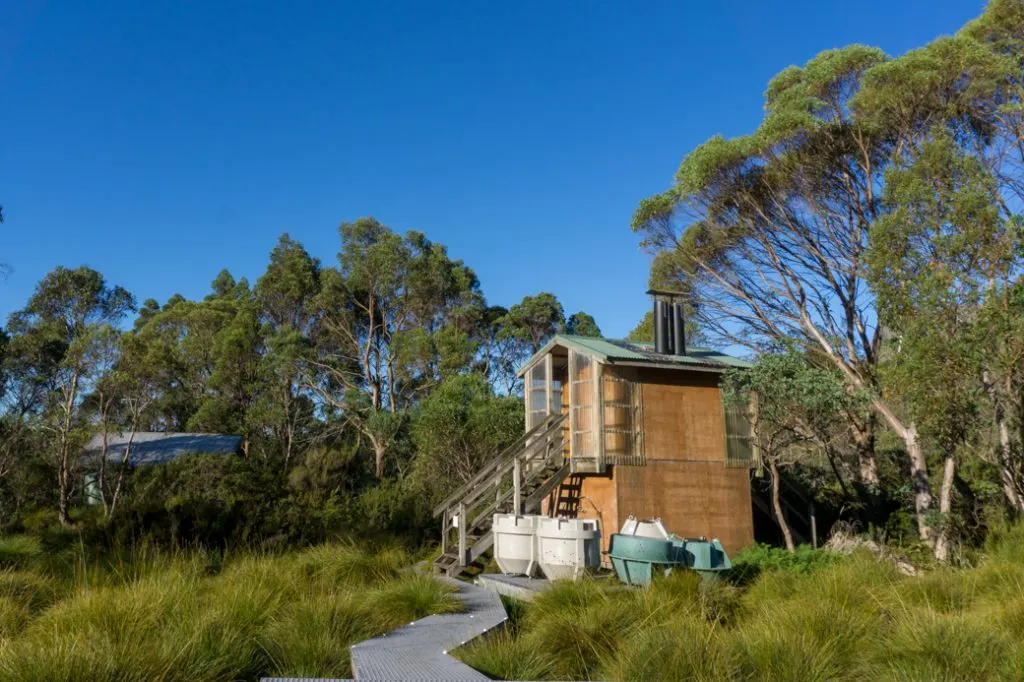
First Aid Kit
You should pack a small first aid kit. Make sure it includes bandages, gauze, medical tape and a compression bandage for sprains.
You’ll also want to have lots of foot care supplies such as Moleskin or Second Skin for blisters. (Check out my full list of blister care and prevention tips and tricks.)
Bring anti-inflammatory painkillers, and anti-diarrhea pills just in case. And of course don’t forget your usual prescription medications.
Your first aid kit should also contain stuff to help repair your gear in case you have any problems. We packed a small multi-tool and some duct tape.
I recommend: I like the Adventure Medical Ultralight first aid kits since they come in a water resistant pouch. I always add more stuff to them, like more blister care and bandaids.
A multi-tool with a knife, pliers and scissors is always handy. I like the Leatherman Wave.
Electronics
Camera
Of course you can bring your phone to use as a camera, but you may want to bring a stand alone camera.
I recommend: I brought my Sony A6000. It’s a mirrorless camera which is more compact than a full DSLR but still produces high quality images. I find it easy to use, plus it’s not that expensive.
Headlamp and Extra Batteries
Bring a headlamp (aka headtorch) to find your way around after dark.
I recommend: I use a Petzl Actik. It’s super bright and easy to use. Plus the batteries last a long time on low power.
Power Bank (Optional)
If you’re bringing electronics, you’ll need a way to keep them all charged. Some people like solar chargers, but with the cloudy weather on the Overland Track, a power bank is more reliable.
I recommend: Bring a power bank that has enough storage to charge your devices at least once, but isn’t too big and heavy. The size you choose will depend on how many devices you bring, but at least 2,500mAh capacity or larger is probably a good idea.
Lantern (Optional)
If you plan to spend a lot time in the huts, you might want to bring a small battery powered lantern. They throw better light than a headlamp and create a cozy atmosphere for cooking, playing cards or hanging out.
I recommend: I have an older Black Diamond Apollo lantern. If you’re looking for something super small yet bright AND solar powered, the Luci lanterns are really cool.
Cooking Gear
Stove, Fuel, and Lighter
Fires aren’t allowed on the Overland Track so you will need to do all your cooking on a fuel stove. Bring a lightweight and compact stove and remember to bring enough fuel for your trip. Don’t forget a lighter!
I recommend: The MSR Pocket Rocket stove is incredibly lightweight and compact.
Cooking Pot
Choose lightweight camping pots. Unless you are making elaborate meals, you probably just need one pot.
I recommend: We use a Primus Primetech pot that has a built in heat exchanger that optimizes fuel consumption and protects the flame from the wind.
Bowl
I recommend: I like the Sea to Summit X Bowls since they are collapsible and I can store them inside my cooking pot.
Mug
You’ll want hot drinks to warm you up on cold evenings. A double-wall insulated mug keeps your drinks warm for longer.
I recommend: I recently upgraded to a swanky Snow Peak Titanium mug. It’s pricey, but it’s soooo light. Plus the double walls keep my morning tea toasty warm.

Knife and Utensils
Bring a sharp knife for cutting, plus a spoon and fork for eating. Or get a spork – they do double duty!
I recommend: I love my Snow Peak Titanium spork. I use a classic Opinel folding knife.
Dishwashing Supplies
We carry a small pot scraper, a tiny microfibre cloth and some biodegradable soap.
Use soap sparingly and be sure to pour your dish water into the grey water pits under the rainwater tank at each campground. Don’t put soapy water directly into streams since even biodegradable soap isn’t safe to go directly into the water. (Read more about how to Leave No Trace.)
I recommend: The GSI compact scraper has a hard edge for scraping stuck on stuff and a spatula-like edge for scraping softer stuff. We use Sierra Dawn camp suds for really greasy dishes.
Food and Water
Water Treatment
There are rainwater tanks at each hut, but the water inside isn’t treated. On the Overland Track we met people who had vomiting and diarrhea from drinking untreated water from the tanks.
We filtered all the water we drank on the Overland Track, including water from the tanks. We were also glad to have the filter on some of the longer days since we could fill up from streams instead of carrying enough water to see us through to the next hut.
I recommend: We brought our Platypus Gravityworks filter. It is really easy to use since there’s no pumping or squeezing. You just hang it up and let it drip through.
Water Bottles
Bring a couple of water bottles or a hydration reservoir. There are streams at regular intervals along the track so you won’t need to carry more than 1.5 or 2 litres at a time.
I recommend: I use a Source Oudoor 2L hydration reservoir so I can keep drinking as I hike.
Food
Bring lots of high calorie food that is lightweight and compact. Don’t forget the snacks! You’ll burn more calories hiking than on a usual day so don’t be afraid to pack a little extra.
I recommend: Check out my tips for choosing the best backpacking meals and my guide to making cheap backpacking meals from grocery store ingredients.
Food Bag
To protect your food from mice, possums and other critters, you need to store your food either inside the huts or deep inside your backpack.
We used a lightweight dry bag to store our food. They are waterproof and the roll-top cuts down on odours, so animals will be less attracted to your food. We met people on the Overland Track who stored their food in plastic grocery bags that fell apart or got chewed through by critters.
I recommend: I used the SealLine Bulkhead View dry bags. They’re waterproof, they have a purge valve to squeeze out excess air and the window makes it easier to figure out what’s inside.
Optional Extra Gear
Trekking Poles
The Overland Track has a lot of steep ascents and descents as well as some rocky terrain. Trekking poles can be really helpful for saving your joints on the downhills or keeping your balance in the mud. I recommend adding trekking poles to your Overland Track packing list.
I recommend: I brought my Black Diamond Trail trekking poles and was really happy to have them.
Bathing Suit and Quick-Dry Towel
There are a few places to go for a quick swim along the Overland Track. All of the lakes and rivers are really COLD, but on a hot day, you might not mind.
Men can likely just wear their trekking shorts as a bathing suit. Women may want to pack a swimsuit just in case, but I usually swim in my sports bra and underwear. If you plan to swim, bring a quick-drying microfibre towel.
I recommend: I like the PackTowl microfibre towels since they dry fast. You can get away with a small one.
Tripod or Selfie Stick
The photography opportunities on the Overland Track are epic. I wish I had brought my tripod!
I recommend: If you’re trying to go really light, get a Joby Gorillapod mini tripod. You can also get an adapter that lets you use it with your phone. I also have a Sirui T-025X Carbon Fiber full-sized tripod that I wished I had brought.
Entertainment for Camp
You’ll have a few hours each night in camp when you’ll need to entertain yourself. Consider bringing a book or some headphones to listen to music or podcasts. The huts can be really social, so a deck of cards or a compact game can be a good way to meet new friends.
I recommend: I always travel with my Amazon Kindle eReader so I have hundreds of books to choose from. We’ve brought the card game Exploding Kittens on a few backpacking trips and it’s always a hit.
Ultralight Chair
All of the huts have picnic tables with benches, but they are often busy. Plus they don’t have backrests, and after a long day on the trail, you’ll really crave a chair.
I recommend: My husband and I both have the ultralight Helinox Chair One. It collapses down really small and weighs about 1kg. My husband brought his on the Overland Track but I opted to leave mine at home to save weight. I was so jealous of his!
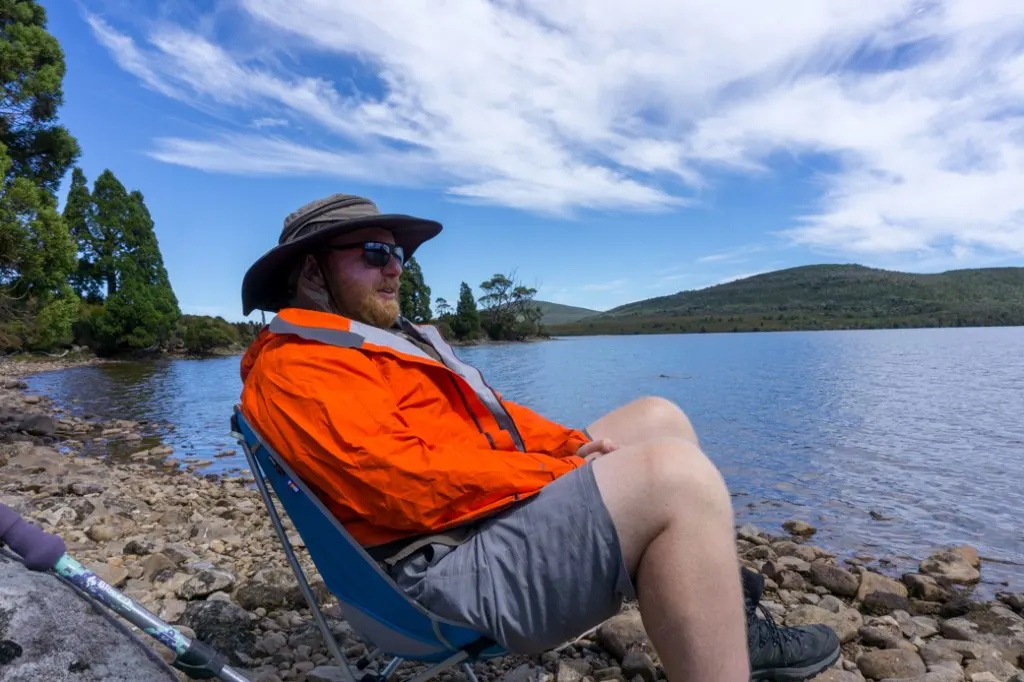
Cord
A short length of paracord or string can come in handy. You can use it to create a clothesline to dry out sweaty gear or a wet towel. Or you can use it to hang damp socks off the back of your pack during the day to dry them in the sun.
I recommend: You don’t need much: 3 or 4 meters of cord should be enough. Buy: REI.
Stuff You Don’t Need to Pack for the Overland Track
Here’s my list of stuff you don’t need and shouldn’t pack for your Overland Track hike:
- Climbing gear: The trails are non-technical and you won’t need harnesses, ropes, crampons, etc.
- Tons of outfit changes: Everyone else will be wearing the same stinky clothes over and over, so you can too. Plus it’s just too heavy to pack an outfit for every day.
- Portable speakers: Most people come to the Overland Track to appreciate the sounds of nature and prefer not to hear your music. The campsites can also be really close together, so you’ll want to keep the noise down.
- Saw or axe: Campfires aren’t allowed, so you won’t need to chop wood.
- Your dog: Dogs are not permitted on the Overland Track
Have you walked the Overland Track? What piece of gear made the biggest difference? Which gear do you recommend other hikers add to their Overland Track packing list? Tell us in the comments.
More Overland Track posts:
- The Ultimate Guide to the Overland Track in Tasmania
- Overland Track Section-by-Section Overview
- 6-Day Overland Track Itinerary (Plus More Itinerary Options)
- Your Guide to All the Overland Track Side Trips
- The Complete Guide to Overland Track Huts and Camping
- Overland Track Transport: How to Get There
- 20+ Ways to Reduce Your Backpack Weight
- Lake O’Hara Packing Lists for Hikers and Campers - April 25, 2025
- BC Parks Day Passes 2025 – Everything You Need to Know - April 24, 2025
- Best Women’s Hiking Pants (Picks for Every Body Type) - April 21, 2025

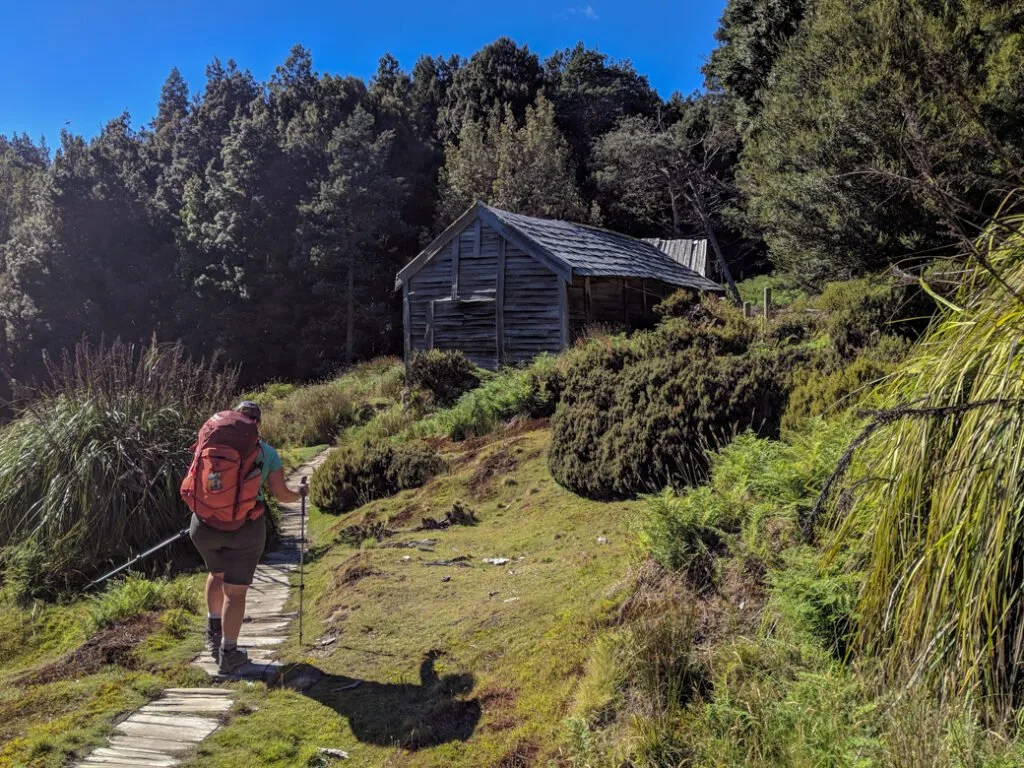
Emma Klymenko
Monday 4th of April 2022
Hi there! Finding so much value in this list, thank you! Did you take the 1.3L or 2.3L pot set? Thank you!
Taryn Eyton
Monday 4th of April 2022
We brought the 2.3L pot because we did cooked pasta in it a few nights - the 1.3L is great for boiling water but doesn't have enough room to easily cook for two people.
CJ
Monday 1st of February 2021
Where/how do we safely leave our main packs when doing side trips?
Taryn Eyton
Tuesday 2nd of February 2021
At most of the junctions for side trips there is a large wooden platform or open area next to the track. Most people leave their packs there. Be sure to put your raincover on and close all your zips to protect your food from currawongs. You can read more about each side trip in this post: https://happiestoutdoors.ca/overland-track-side-trips/
KJ
Friday 1st of November 2019
How much fuel did you use/carry? I will be using the same type for at least coffee in the mornings and rehydration of evening meals. Thanks for posting all your helpful tips for the overland track.
Taryn Eyton
Friday 1st of November 2019
We took two of the 250g canisters. We only used one canister though. However, if it had been colder or rainier, I think we would have made hot drinks more often and used a bit more fuel. I think I'd bring a 250g canister and one of the tiny 110g canisters next time. It really depends how efficient your stove is - you may need more fuel than I did.
Sophie
Wednesday 30th of October 2019
Also... what about taking fuel canisters with us, or we have to buy all in Tasmania? Are there a lot of hiking and trekking shops or is all this stuff availible at the Woolies?
I think it is not aloud to fly with the fuel canisters.
Thanks again!
Taryn Eyton
Wednesday 30th of October 2019
That's right, you cannot fly with fuel canisters. You can buy them when you arrive in Tasmania at a camping store - Woolies doesn't have them. Most Overland Track transport companies sell fuel. If you arrange with them in advance, they'll bring you some fuel when they pick you up to drive you to the track. That's the easiest way to do it.
Sophie
Wednesday 30th of October 2019
Hi!
I loved this extended version about the Overland track and your tips!
What I want to know (as we fly from sydney 1 day before), did you just bought all the food in Tasmania?
I am already found some proteine bars and other stuff but if we have to buy a box of pasta, rice etc while we only need a bit in our zip backs, it is a waste to buy it when we arrive.. do you recommend flying from sydney already with all the dried food?
Thanks!
Taryn Eyton
Wednesday 30th of October 2019
Hi Sophie, You can definitely buy food in Tasmania if you want, but the selection of freeze dried backpacking food is not nearly as good as what you will find in Sydney or other big cities. We bought all our food in Tasmania since we had been living there for a month before our trip. You can find backpacking meals at some sports stores (BCF for example) but it's not as easy to find as it would be in a big city like Sydney.